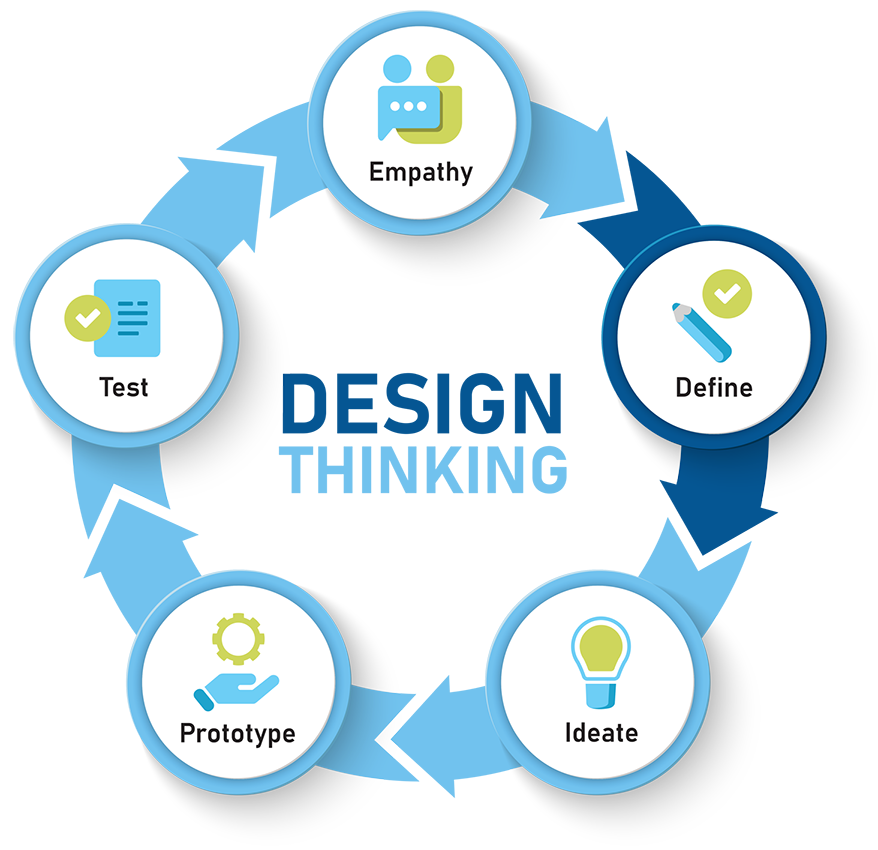DEFINE: The Blueprint of Design Thinking
Posted on March 12, 2024
By Nick Chiechi, President, CS Designworks

In the dynamic journey of design thinking, where empathy lays the groundwork for understanding user needs, the second phase, Define, acts as the blueprint for innovation. This critical step is where CS Designworks, a champion of user-centered design, sharpens its focus to pinpoint the exact challenges to be addressed. By defining the problem clearly, every project transitions from broad insights to targeted solutions, ensuring that the end result is not just a product, but a solution tailored to real user needs.
 The Phases of Design Thinking
The Phases of Design Thinking
Empathy: Understanding Your Users
Define: Framing the Problem
Ideate: Generating Solutions
Prototype: Bringing Ideas to Life
Test: Refining the Solution
Let’s Define Define
The Define phase is where the empathy gathered from users is distilled into a clear, actionable problem statement. This is the moment of clarity in the design thinking process, where vague understandings are transformed into focused objectives. It’s about synthesizing the collected data to identify core issues that design solutions can address.
For business owners, the Define phase is crucial. It sets the direction for the entire project and ensures that efforts are concentrated on solving the right problems. This phase demands critical thinking and a deep understanding of the insights gained during the Empathy phase, challenging teams to ask, "What are we really trying to solve?"
Activities in the Define Phase
Data Synthesis: Gathering and organizing data from the Empathy phase to highlight patterns and insights.
Problem Statement Development: Crafting a clear, concise statement that summarizes the problem to be solved.
Stakeholder Mapping: Identifying all stakeholders affected by the problem and potential solutions.
User Persona Creation: Developing detailed profiles of target users to keep the design process user-centered.
These activities help in creating a focused lens through which the design team can view the challenge. By clearly defining the problem, solutions can be more effectively ideated, prototyped, and tested.
Define in Action at CS Designworks
At CS Designworks, the Define phase is where strategic thinking takes center stage. It’s where we take the rich insights gained from our empathy work and sharpen them into a focused problem statement that guides our creative process. This phase is about asking the right questions and challenging assumptions to ensure that our solutions are not just innovative but also relevant and impactful.
For example, if during the Empathy phase we learn that users feel disconnected from a digital platform's community features, the Define phase helps us pinpoint the problem: "Users need a more engaging and intuitive way to connect with the community within the platform." This clear definition guides our ideation process towards solutions that enhance user engagement and community feeling.
Conclusion
The Define phase is the critical bridge between understanding user needs and creating solutions that meet those needs. It’s where the possibilities uncovered during the Empathy phase are honed into a clear direction for innovation. For business owners, mastering this phase means ensuring that your products and services are not just well-designed but are also deeply aligned with the needs of your users.
As demonstrated by CS Designworks, the Define phase is not just a step in the process; it's the blueprint for creating solutions that resonate on a deeper level. By clearly framing the problem, businesses can focus their creativity and resources on innovations that truly matter, enhancing the lives of their users and fostering lasting connections.
Define in Action: A Hypothetical Example for a Commercial Real Estate Company |
|
Following the journey of "UrbanSpace Innovators," a commercial real estate company that embarked on an empathetic exploration to better understand their clients' dissatisfaction with office spaces, we now delve into the Define phase of their design thinking process. This phase is crucial as it transforms the raw, empathetic insights into a clear, actionable problem statement that guides the solution development process. Recap of Empathy Phase InsightsUrbanSpace Innovators discovered through observation, engagement, and immersion that their tenants, comprising small businesses, startups, and freelancers, were frustrated with the lack of flexibility, personalization, and community within their office spaces. Despite the modern aesthetics and prime locations, the spaces did not foster a sense of belonging or collaboration, which tenants valued highly. |
|
Transition to Define Phase Activities in the Define Phase Defining the Problem Impact of the Define Phase Wrapping It All UpBy meticulously defining the problem, UrbanSpace Innovators set the stage for ideating solutions that could transform their office spaces into environments where businesses could thrive, collaborate, and feel a sense of belonging. This example illustrates the power of the Define phase in turning empathy into action, providing a solid foundation for meaningful innovation in the commercial real estate sector. |
Next Up: Phase 3 – Ideate
Stay tuned for our next deep dive into the Ideate phase of Design Thinking, where ideas begin to take shape.
Previous: Phase 1 – Empathy
Read our Design Thinking Overview
Join Our Blog Community
@CSDesignworks


